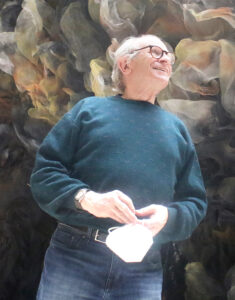With Airy Mesh, Richard Friedberg Captures…
Nature’s Might
Oneonta Sculptors ‘Terrible Beauty’ Opens At Munson-Williams-Proctor
By JIM KEVLIN • Special to www.AllOTSEGO.com

As 2010 arrived, Richard Friedberg was feeling “dispirited, unhappy that we did not have a great chance of solving our environmental problems, our climate problems.”
“I needed a change,” said Friedberg, who has a studio in a Harpersfield barn, halfway from Oneonta to Stamford.

Then, on April 20, change arrived: BP’s Deepwater Horizon oil platform exploded; 11 workers died, 17 more were injured. After two days of billowing flames, the rig sank into the Gulf of Mexico, and oil – 60,000 barrels a day at the peak – began to pour through a ruptured riser.
What resulted was the largest oil spill in history.
The artist had found his muse.
Friedberg had watched “the incredible fire.” He was “compelled by the awesomeness of the catastrophe.”
In the Atrium of Utica’s Munson-Williams-Proctor Art Institute the other day, where his show, “Terrible Beauty,” will run from Saturday, Feb. 27, through May 30, he searched for the right word to describe the disaster.
“Apocalyptic,” he said.
He began to experiment with a series of models and multiple materials. Then came a technical breakthrough. He began working with an aluminum mesh that allowed “compressions and expansions.” As he described it: the ability to capture change and fluidity in the physical world.
Each resulting piece is “very elusive. It’s evocative. It can mean a lot of different things,” the sculptor said. “It’s a Rorschach Test.”
The first outgrowth was “Macondo” – after the Gulf’s Macondo Prospect, which BP had leased for its oil and gas explorations.
As it turned out, in the decade that followed there was no lack of inspiration for Friedberg’s artistic explorations – Fukushima, the 2011 nuclear-plant explosion; Isis blowing up an Iraqi oil field in 2017, and much more.
In his Delaware County barn, one sizeable catastrophe-inspired sculpture after another took shape – “Fire Storm,” “Heavy Seas,” “Dark Wave.”
While Friedberg was inspired by environmental catastrophes, he emphasizes: “I’m not a person approaching sculpture from a political or social point of view,” preferring to have his fans come to their own conclusions.
Five years ago, Friedberg and Mary E. Murray, M-W-P curator of Contemporary & Modern Art began discussing what became of the nine-sculpture “Terrible Beauty.”
As its assembly began, another catastrophe hit, COVID-19, which “heightens the relevancy of Mr. Friedberg’s artworks,” M-W-P President/CEO Anna T. D’Ambrosio wrote in the exhibit’s catalogue.
Murray praised the exhibit’s “strength and coherence.”
Friedberg was living in Soho when demand for housing began pushing artists out of their lofts; he needed more space, anyhow. “I began drawing concentric circles from New York City on a map, until I found a place I could afford.” He moved to Delaware County.
Since then, he’s exhibited his works at Hartwick College’s Yager Museum, lectured at SUNY Oneonta and generally put himself in the local art scene. He’s impressed by the range of artists locally, but added, “Sculpture is never dominant in the total artistic universe.”

